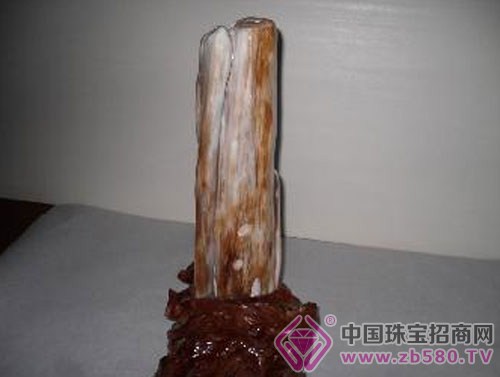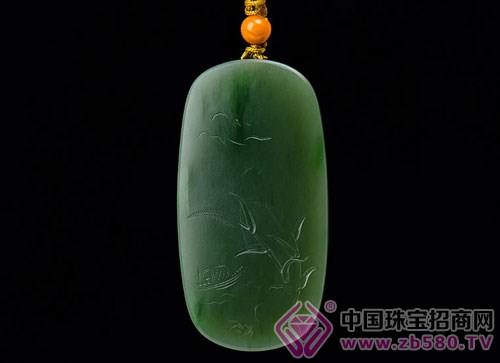The tree jade is a jadeized wood. It belongs to silicified wood and is distinguished from ordinary silicified wood by its crystal clear appearance. In the course of a long history, large virgin forests were buried underground by vast natural forces. In a high-pressure, low-temperature and oxygen-free environment immersed in silica, the carbon in the trees is gradually replaced by silica, partially retaining some of the original characteristics of the tree and incorporating some mineral elements into the surrounding rock. To form a colorful color material, this is silicified wood, also known as wood fossil. After a long geological period, in the constant changes of temperature and pressure, silicified wood has undergone different metamorphism, recrystallization, and the main components are converted into opal chalcedony, which is called tree jade, also known as wood jade.

The characteristics of tree jade and jade
There are five characteristics: First, from the appearance, it is a segment of trees, it maintains all the shape characteristics of the trees, it shows the bark, tree shrews, tree knots, tree knots, wood fibers, all saved. The original form of the trees. The simple, heavy and vicissitudes of this kind of nature are not found in ordinary jade. The jade shows us the sleek, random, cobblestone or irregular stone.
Second, from the cross-sectional shape, it is first a piece of trees. It clearly and completely preserves the original annual rings, textures and cavities of the trees, and is a complete preservation of the internal morphology of ancient trees. Through the microscope, people can even find traces of the shape of the layer cells, cell walls, and water conduits formed by the phloem of the trees. Jade is often an ore that is neatly arranged and has a very simple structure. Although it also has textures, this texture is naturally generated and has a strong randomness. The main value is reflected in people's appreciation.
Thirdly, from the color point of view, since the formation of tree jade is a process of replacing the raw lignocellulosic fiber and carbonaceous material with minerals, the difference in minerals replaced by various regions and historical periods has caused the tree jade. The colors are colorful and often richer than ordinary jade. The tree jade mainly has white, gray, yellow, brown, red, purple, green, black, blue and other colors; and jade generally shows the various colors of white to green transition, until the bright green. Although there are other colors, such as gray, yellow, red, and black, but the number is small, so when it comes to jade, the first thing we think of is green or white.
Fourth, from the perspective of resources, although both are rare mineral deposits, the beauty of tree-based jade lies in the fact that the shape, color, internal quality and texture of each tree jade are varied and unpredictable. To find two trees of color, texture, shape, water, and similar size, it is like a needle in the sea. It is to cut the same tree into several sections, and its tree, color and shape are still different. Therefore, the tree jade you like is often a piece of humanity that can't be met . And people can easily find two or even a batch of similar or similar jade jade.

Fifth, from the point of view of use, first of all, tree jade is a plant fossil formed by nature. It is a book that studies ancient meteorology, other biological and geographic materials, and has valuable archaeological and scientific research value. Secondly, in the process of planting jade, not only can make small ornaments such as carvings, pendants, ornaments, etc., but also can make large-scale carvings. What is commendable is its peculiarity. People often use it as a decoration of the courtyard without modification, or as a symbol of good luck and tranquility for the gem of the town house at home. Jade has very few scientific research values, and can only be carved into small ornaments, jewelry, pendants and other small ornaments. While people appreciate its beautiful texture, it mainly appreciates its carving process.
However, from the texture of tree jade and jade, their brilliance, crystal clear and translucent, the feeling of warm and greasy hands, comfortable and cool is the same, and from the mineral composition, hardness, density, etc. Item physical property analysis, they are similar. You said that the tree jade, also known as silicified wood, is a very hard material. It is difficult to grind it with ordinary machines that polish crystal or jade bracelets. Even if it can be polished, the scrap rate is also very high. Therefore, there is almost no entire bracelet made of siliconized wood on the market, only a bracelet made of beads or a square hand.
The color of silicified wood is not the same. Available in green, black, white, yellow and red. The formation of color is related to the combination of wood and metal elements. Green is the combination of copper in the formation process, black in combination with manganese, aluminum in the white part, and iron in the red part. So it doesn't matter which color is good.
The quality of silicified wood is divided by the degree of jade of the trees. A simpler way to distinguish is to use a strong light flashlight. Turn on the light of the flashlight and close it to the silicified wood. If you can see the light through the surface to reach the inside, even if most of the light is visible, it indicates that the degree of jade is high. On the contrary, if there is no light, it means that the degree of jade is low and the quality is poor.
Camel Hair Gloves,Camel Hair Gloves Knitting,Camel Hair Gloves Korean,Camel Hair Gloves Design
BAOTOU TONGHEXING CASHMERE PRODUCTS CO.,LTD , https://www.cashmeregorgeous.com